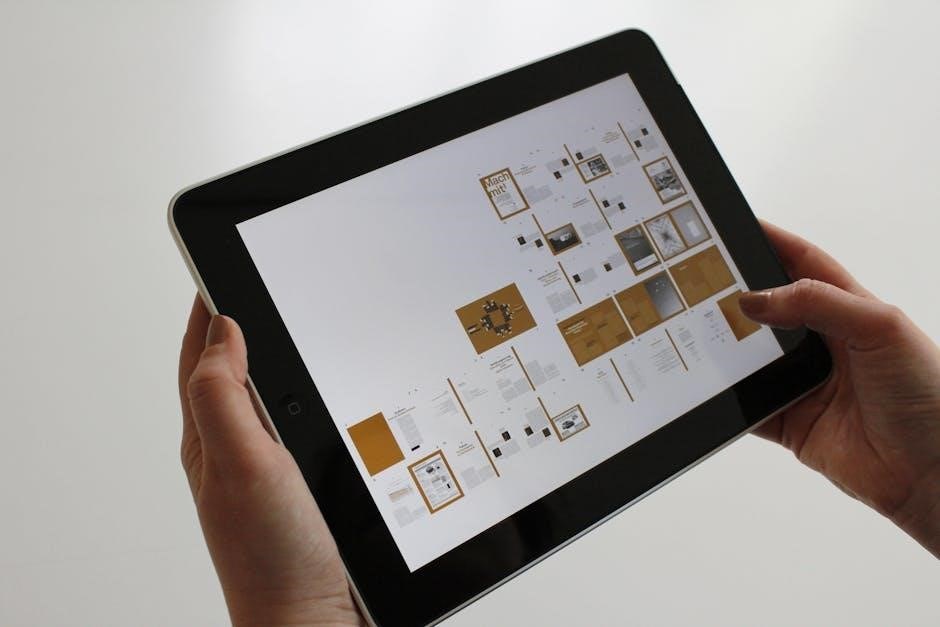This manual provides a comprehensive guide for the Fluke 754‚ covering installation‚ operation‚ and troubleshooting. It ensures safe and effective use for all users.
1.1 Purpose of the Fluke 754 User Manual
The Fluke 754 User Manual is designed to provide detailed guidance for the safe and effective use of the device. It covers installation‚ operation‚ calibration‚ and troubleshooting‚ ensuring users can maximize the tool’s capabilities. The manual also includes sections on HART communication‚ warranty information‚ and maintenance tips. By following the instructions‚ users can optimize performance‚ resolve common issues‚ and extend the lifespan of the Fluke 754. This comprehensive guide is essential for technicians‚ engineers‚ and professionals working with precision measurement and calibration tasks.
1.2 Scope of the Manual
This manual provides a comprehensive guide for the Fluke 754‚ detailing its installation‚ operation‚ and calibration. It covers troubleshooting‚ HART communication‚ and maintenance tips. The manual includes technical specifications‚ operational procedures‚ and safety precautions. Users will find detailed instructions for maximizing the device’s capabilities and resolving common issues. The scope ensures all aspects of the Fluke 754 are addressed‚ from basic setup to advanced features‚ making it an essential resource for professionals working with precision measurement tools.
1.3 Intended Audience
This manual is designed for engineers‚ technicians‚ and maintenance personnel working with the Fluke 754. It serves professionals in process control‚ automation‚ and industrial settings. The guide is also useful for calibration specialists and those requiring precise measurement tools. Whether you’re installing‚ operating‚ or troubleshooting the device‚ this manual provides essential information. It is tailored for users who need to understand and utilize the Fluke 754’s advanced features effectively in their work environment.
Product Overview
The Fluke 754 is a highly regarded precision tool designed for process industries and automation‚ offering versatility and performance in various applications.
2.1 Description of the Fluke 754
The Fluke 754 is a precision calibrator designed for process industries and automation. It combines a rugged design with advanced functionality‚ making it ideal for field and laboratory use. The device features a high-resolution display‚ intuitive interface‚ and robust construction to withstand demanding environments. It is engineered to deliver accurate measurements and calibration for pressure‚ temperature‚ and electrical signals. Built for reliability and ease of use‚ the Fluke 754 is a versatile tool for professionals requiring precise control and measurement in industrial settings.
2.2 Key Features of the Fluke 754
The Fluke 754 offers a range of advanced features tailored for precise industrial calibration. It supports pressure‚ temperature‚ and electrical signal calibration‚ ensuring versatility in process control applications. The device includes HART communication capability‚ enabling seamless integration with smart devices. Additional features include data logging‚ internal storage for calibration results‚ and a user-friendly interface. Its rugged design ensures durability in harsh environments‚ while the high-accuracy measurements and long battery life make it a reliable choice for field and laboratory use. These features enhance efficiency and accuracy for professionals in process industries.
2.3 Differences from Other Fluke Models
The Fluke 754 excels with enhanced measurement accuracy and advanced HART communication. It offers superior data logging capabilities and a more intuitive user interface compared to other models. Its rugged design ensures reliability in harsh industrial environments‚ making it the ideal choice for professionals requiring high precision and durability for field use.

Features and Functionalities
The Fluke 754 offers advanced measurement capabilities‚ robust data logging‚ and versatile connectivity options. It supports custom unit configurations‚ ensuring flexibility for various industrial applications and precise data management.
3.1 Advanced Measurement Capabilities
The Fluke 754 offers superior measurement capabilities‚ supporting temperature‚ pressure‚ voltage‚ and current with high accuracy. It handles various physical parameters‚ ensuring comprehensive data acquisition. With simultaneous measurements and real-time monitoring‚ it’s ideal for industrial applications. The device’s precision and reliability make it a top choice for professionals needing accurate and efficient measurements in demanding environments‚ enhancing productivity and decision-making.
3.2 Data Logging and Storage
The Fluke 754 provides robust data logging and storage capabilities‚ enabling users to record up to 1‚000‚000 readings. Data can be logged manually or automatically at configurable intervals. Stored data is organized in CSV format for easy analysis. The device supports expandable storage via SD cards‚ ensuring ample space for large datasets. Data retrieval is straightforward‚ with options to transfer data to a computer via USB or through dedicated software‚ making it ideal for long-term monitoring and detailed analysis in industrial environments.
3.3 Connectivity Options
The Fluke 754 offers versatile connectivity options to streamline data transfer and device integration. It features a USB interface for quick connection to PCs and laptops‚ enabling easy data download and configuration. Additionally‚ the device supports RS-232 communication for legacy systems. The HART communication capability allows for seamless integration with smart devices and industrial networks. Bluetooth connectivity is also available‚ enabling wireless communication with compatible mobile devices. These options ensure flexibility in various industrial environments‚ supporting both fieldwork and system integration.
3.4 Custom Units and Configuration
The Fluke 754 allows users to define custom units‚ enabling tailored measurements for specific applications. This feature is particularly useful for industries with unique requirements; Custom configurations can be easily set up via the device’s interface or through Fluke’s software tools. Users can adjust scaling factors‚ create specialized measurement ranges‚ and assign custom labels. These configurations enhance flexibility and accuracy‚ ensuring measurements align with industry-specific standards. The ability to save and recall custom settings streamlines workflows‚ making the Fluke 754 adaptable to diverse operational needs.

Technical Specifications
This section provides detailed performance metrics‚ accuracy levels‚ and operational parameters of the Fluke 754‚ ensuring users understand its capabilities and environmental requirements for precise measurements.
4.1 Performance and Accuracy
The Fluke 754 delivers exceptional precision with a measurement accuracy of ±0.025% of reading ±0.01% of full scale. It supports multiple measurement ranges‚ ensuring versatility across applications. The device operates within a temperature range of -10°C to 55°C‚ maintaining accuracy in various environments. With a response time of less than 100 ms‚ it provides real-time data for efficient troubleshooting. The 754 also meets international standards‚ including ISO 9001‚ ensuring reliability and consistency in industrial and laboratory settings. Its high-resolution display enhances readability for precise measurements.
4.2 Environmental and Operational Conditions
The Fluke 754 operates effectively in environments with temperatures ranging from -10°C to 55°C and relative humidity up to 95% non-condensing. For storage‚ the recommended temperature is -40°C to 70°C. The device is designed to withstand industrial conditions‚ including electromagnetic interference‚ and meets IP54 ratings for dust and water resistance. Ensure the device is used in well-ventilated areas to prevent overheating. Proper environmental conditions ensure optimal performance and extend the product’s lifespan. Always follow storage guidelines to maintain calibration and functionality.
4.3 Compliance and Certifications
The Fluke 754 complies with international standards and holds certifications ensuring safety and performance. It meets ISO/IEC 17025 for calibration accuracy and adheres to IEC 61010-1 safety standards. The device is CE marked for European Union compliance and is UL certified for U.S. markets. Additional certifications include RoHS compliance‚ ensuring environmentally friendly materials. These certifications confirm the Fluke 754’s reliability and adherence to global regulatory requirements‚ making it suitable for use in various industrial environments worldwide. Proper compliance ensures safe and accurate operation across different regions and applications.

Installation and Setup
5.1 Unboxing and Initial Inspection
When you receive the Fluke 754‚ carefully unbox it and inspect for any visible damage. Verify all components‚ including the device‚ batteries‚ and accessories‚ are included. Check for any signs of tampering or physical damage. Ensure the display is clean and functioning properly. If any discrepancies or damage are found‚ contact Fluke support immediately. This step ensures the device is in proper working condition before proceeding with installation or use.
5.2 Installation Requirements
The Fluke 754 should be installed in a stable‚ vibration-free environment. Ensure the location is within the specified temperature and humidity ranges. Connect the device to a power supply that meets the required voltage and frequency. Verify all cables and connectors are securely attached. Use the provided mounting hardware to ensure proper alignment and stability. Refer to the installation checklist to confirm all prerequisites are met before powering on the device. Proper installation ensures accurate performance and longevity of the Fluke 754.
5.3 Mounting and Connectivity Setup
Mount the Fluke 754 on a flat‚ stable surface using the provided mounting brackets. Ensure the device is level and secure to prevent vibration interference. Connect the power cable to a suitable power source‚ ensuring polarity is correct. Attach input cables to the appropriate terminals‚ tightening all connections firmly. For communication‚ connect the RS-232 or USB cable to a compatible device. Verify all connections are snug to avoid signal loss. Refer to the wiring diagram for correct terminal assignments. Proper mounting and connectivity ensure reliable operation and accurate measurements. Follow the setup checklist to confirm all connections are correct.

Operating Instructions
Power on the device‚ navigate the menu using the touchscreen or buttons‚ and select the desired mode. Follow on-screen prompts for measurement setup and execution.
6.1 Basic Operation and Navigation
Power on the Fluke 754 and allow it to complete the self-test. Navigate the menu using the touchscreen or keypad. Select the desired measurement mode (e.g.‚ pressure‚ temperature) from the home screen. Use the arrow keys to adjust settings or scroll through options. The display shows real-time measurements and menu prompts. For basic measurements‚ connect the appropriate sensor‚ ensure proper setup‚ and follow on-screen instructions. Use the “Back” button to return to previous menus. Refer to the manual for specific button functions and navigation shortcuts to streamline operations.
6.2 Advanced Operating Techniques
Access advanced features by pressing and holding the Menu button. Configure custom units‚ apply math functions‚ or enable data logging for extended monitoring. Use the Shift key to toggle between primary and secondary functions. For precise measurements‚ utilize the Zoom feature to magnify readings. Enable alarms for set thresholds and review stored data via the Recall option. Explore the Setup menu to customize display settings‚ measurement intervals‚ and communication parameters. Refer to the manual for detailed steps on leveraging these advanced capabilities effectively.
6.3 Using HART Mode
To activate HART mode on the Fluke 754‚ press and hold the Menu and Shift buttons simultaneously for 3 seconds. This enables communication with HART-compatible devices. Use the Up and Down arrows to navigate through HART menus and configure device parameters. Perform loop diagnostics‚ adjust sensor settings‚ or verify device information. Ensure the device is in a safe state before making changes. Refer to the HART protocol documentation for detailed command descriptions. Always exit HART mode properly to avoid data corruption.

Calibration Procedures
Calibration ensures the Fluke 754 operates with precision and accuracy. Follow detailed procedures in this section to maintain device performance and reliability over time.
7.1 Pre-Calibration Checks
Before calibrating the Fluke 754‚ perform a series of preliminary checks to ensure optimal conditions. Verify the device is free from physical damage or wear. Check all connections for security and integrity. Ensure the device is powered on and functioning normally. Review the calibration history to confirm the need for recalibration. Verify that the firmware is up to date for accurate performance. Inspect the calibration accessories for proper condition. Ensure the environment is stable and free from interference. Record initial readings for baseline comparison. Prepare all necessary tools and documentation before proceeding.
7.2 Front Beam Calibration
To perform front beam calibration on the Fluke 754‚ power on the device and navigate to the calibration menu. Select “Front Beam Calibration” and follow the on-screen instructions. Ensure the load cell is at zero load before proceeding. Use the “Zero” button to set the no-load condition. Apply a known weight to the front beam‚ ensuring it matches the specified range. Press “Apply” to store the calibration data. Verify the calibration by measuring a known weight to ensure accuracy. Repeat if necessary to achieve optimal results;
7.3 Rear Beam Calibration
To calibrate the rear beam of the Fluke 754‚ start by powering on the device and accessing the calibration menu. Select “Rear Beam Calibration” and follow the prompts. Ensure the rear beam is at zero load before initiating the process. Use the “Zero” function to set the no-load condition. Apply a known weight to the rear beam‚ ensuring it aligns with the specified range. Press “Apply” to save the calibration data. Verify accuracy by measuring a known weight. If necessary‚ repeat the process to achieve precise results.
7.4 Post-Calibration Procedures
After completing calibration‚ verify the accuracy of measurements by testing with known values. Record the calibration date and results for future reference. Store the device in a protective case to prevent damage. Regularly review calibration records to ensure compliance with maintenance schedules. Update calibration certificates if required by regulatory standards. Perform a final system check to ensure all functions operate correctly. Refer to the Fluke 754 user manual for specific post-calibration guidelines tailored to your application.

HART Communication
HART Communication enables seamless data exchange between devices in process control. This standard facilitates integration with the Fluke 754‚ enhancing operational efficiency and real-time monitoring capabilities.
HART (Highway Addressable Remote Transducer) is a communication protocol enabling two-way digital communication between field devices and control systems. It enhances process monitoring and control by providing real-time data access and configuration capabilities. HART integrates seamlessly with analog systems‚ supporting both 4-20mA signals and digital communication. Its flexibility allows for device configuration‚ diagnostic data retrieval‚ and advanced control strategies. The Fluke 754 leverages HART technology to ensure precise‚ efficient communication in industrial environments‚ making it a valuable tool for modern process control applications.
8.2 Configuring HART Communication
Configuring HART communication on the Fluke 754 involves setting up the device to communicate with HART-compatible instruments. Ensure the device is in HART mode and connected to the instrument. Use the Fluke 754’s interface to select communication parameters such as baud rate and device address. Follow on-screen prompts to configure the communication settings. Verify connectivity by performing a test communication to ensure data transfer. Refer to the device’s menu for advanced configuration options‚ such as setting custom tags or adjusting communication intervals. Proper configuration ensures seamless integration with HART-enabled devices.
8.3 Troubleshooting HART Issues
Troubleshooting HART communication issues on the Fluke 754 involves identifying common problems such as connectivity failures or data transfer errors. Check that the device is properly connected to the HART instrument and that all cables are secure. Verify that the communication settings‚ including baud rate and device address‚ are correctly configured. If issues persist‚ perform a power cycle on the device or reset HART communication. Ensure the latest firmware is installed‚ as outdated software may cause compatibility problems. Refer to the device’s diagnostic tools for detailed error messages and solutions.
Troubleshooting
Identify and resolve common issues with the Fluke 754‚ such as display malfunctions or measurement inaccuracies. Refer to diagnostic tools and troubleshooting guides for detailed solutions.
9.1 Common Issues and Solutions
Address frequent problems with the Fluke 754‚ such as faulty display readings or inaccurate measurements. Common issues include incorrect calibration‚ loose connections‚ or software glitches. Solutions involve checking sensor connections‚ recalibrating the device‚ or updating firmware. For display issues‚ ensure proper brightness settings or replace the battery if necessary. Consult the troubleshooting guide for step-by-step solutions to restore optimal performance and accuracy. Regular maintenance and updates can prevent recurring issues and ensure reliable operation.
9.2 Error Messages and Diagnostics
The Fluke 754 displays specific error codes to indicate malfunctions. Codes like “Err1” or “Err2” signify issues such as sensor faults or communication errors. Use the diagnostic menu to identify the root cause by navigating to the “Diagnostics” section. Review the error log for detailed information and follow on-screen instructions to resolve issues. Ensure all connections are secure and restart the device if necessary. Refer to the troubleshooting guide for interpreting error codes and performing corrective actions to restore functionality.

Maintenance and Care
Regularly clean the device to prevent contamination and ensure accurate measurements. Check battery life and replace as needed. Store in a dry‚ cool place to prevent damage. Handle with care to maintain calibration and functionality.
10.1 Routine Maintenance Tasks
Perform regular cleaning of the Fluke 754 using a soft cloth and mild detergent to prevent dust and debris buildup. Check and replace batteries as needed‚ ensuring proper polarity. Update the device’s software periodically to maintain optimal performance. Inspect the connectors and ports for damage or corrosion and clean them gently with a cotton swab. Avoid exposing the device to harsh chemicals or extreme temperatures. Store the Fluke 754 in its protective case when not in use to prevent physical damage. Always use Fluke-approved accessories to maintain warranty validity.
10;2 Storage and Handling Best Practices
Store the Fluke 754 in its original protective case to prevent damage. Keep it in a dry‚ cool environment‚ avoiding direct sunlight and extreme temperatures. Handle the device with care to prevent drops or impacts. Clean the device before storage to ensure optimal condition. Avoid exposing it to chemicals or corrosive substances. Use protective covers for connectors and ports. Store batteries separately if the device will not be used for an extended period. Ensure the device is secure during transport to prevent movement or vibration damage.

Safety Precautions
Always follow safety guidelines when using the Fluke 754. Avoid exposure to high voltages and ensure proper grounding. Wear protective gear‚ including insulated gloves and safety glasses. Keep the device away from flammable materials and avoid use in hazardous environments. Never modify the device or bypass safety features. Ensure all connections are secure to prevent electrical shock or malfunction. Follow all applicable safety standards and regulations during operation and maintenance.
11.1 General Safety Guidelines
Always handle the Fluke 754 with care to avoid damage or injury. Ensure the device is used in a well-ventilated area‚ away from direct sunlight and moisture. Avoid touching electrical components or terminals unless properly insulated. Use protective equipment‚ such as gloves and safety glasses‚ when working with high-voltage or hazardous systems. Never modify the device or bypass safety features. Keep the device out of reach of children and unauthorized personnel. Follow all local safety regulations and standards during operation‚ calibration‚ and maintenance. Regularly inspect the device for damage or wear and tear.
11.2 Electrical Safety Considerations
When working with the Fluke 754‚ ensure all electrical connections are made to circuits rated for the device’s power requirements. Avoid exposing the device to live circuits without proper insulation or protective gear. Ground the instrument correctly to prevent shock hazards. Keep the device away from water and moisture to avoid electrical faults. Use only Fluke-approved power supplies and avoid overloading circuits. Never modify the device’s electrical components‚ as this can compromise safety and void the warranty. Always disconnect power before servicing or maintaining the unit. Handle test leads with care to prevent accidental short circuits. Store the device in a dry‚ secure location to prevent damage. Follow all local electrical safety standards and guidelines when operating the Fluke 754.
- Avoid contact with live electrical components without proper PPE.
- Ensure proper grounding of the device and test setup.
- Prevent moisture exposure to maintain electrical integrity.
- Use only authorized power sources and accessories.
- Regularly inspect cords and leads for damage.

Warranty and Support
12.1 Warranty Terms and Conditions
The Fluke 754 is backed by a standard one-year warranty covering defects in materials and workmanship. Extended warranties may be available through authorized distributors.
12.2 Contacting Fluke Support
For assistance‚ contact Fluke support via phone‚ email‚ or the official website. Regional support centers ensure prompt service and technical expertise for optimal device performance.
The Fluke 754 Documenting Calibrator is covered by a limited warranty that ensures defect-free materials and workmanship for a specified period. The warranty typically lasts for one year from the date of purchase‚ but extended warranty options may be available. To be eligible‚ the product must be registered within 30 days of purchase. The warranty covers repairs or replacements at Fluke’s discretion but does not apply to damage caused by misuse‚ neglect‚ or unauthorized modifications. For full details‚ refer to the warranty terms provided with the product.
- Coverage includes parts and labor for manufacturing defects.
- Batteries and consumables are excluded from warranty coverage.
- Warranty void if the product is tampered with or modified.
Always retain the original purchase receipt and registration confirmation for warranty claims.
For any inquiries‚ technical assistance‚ or service-related matters‚ users can contact Fluke support through various channels. Fluke offers 24/7 customer support in multiple languages. You can reach them via phone‚ email‚ or through the official Fluke website. Additionally‚ live chat support is available for immediate assistance. Fluke also provides regional contact numbers and a comprehensive FAQ section on their website. Ensure to have your device’s serial number and model number ready for efficient support. Visit the Fluke website for more details.
The Fluke 754 is a powerful tool designed to enhance productivity and accuracy in industrial measurements. By mastering its features and following this manual‚ users can optimize performance and reliability.
13.1 Summary of Key Points
The Fluke 754 user manual provides comprehensive guidance for optimal use of the device. It covers installation‚ operation‚ and maintenance‚ ensuring precise measurements and longevity. Key features include advanced measurement capabilities‚ data logging‚ and HART communication. Calibration procedures are detailed to maintain accuracy‚ while troubleshooting sections address common issues. Safety precautions and warranty information are emphasized for user protection and support. By following this manual‚ users can maximize the Fluke 754’s performance and reliability in various industrial applications.
